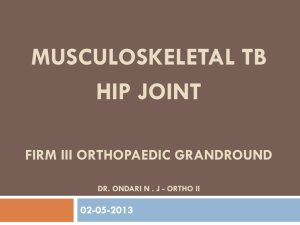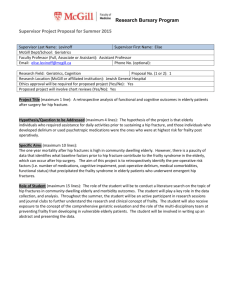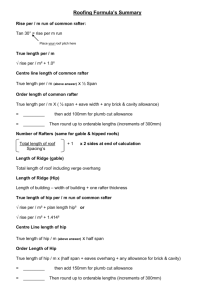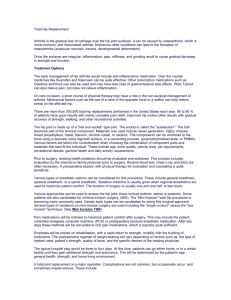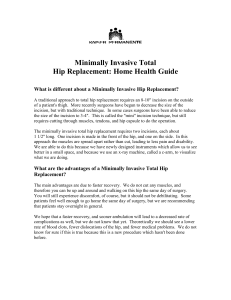hip pain in runners
advertisement
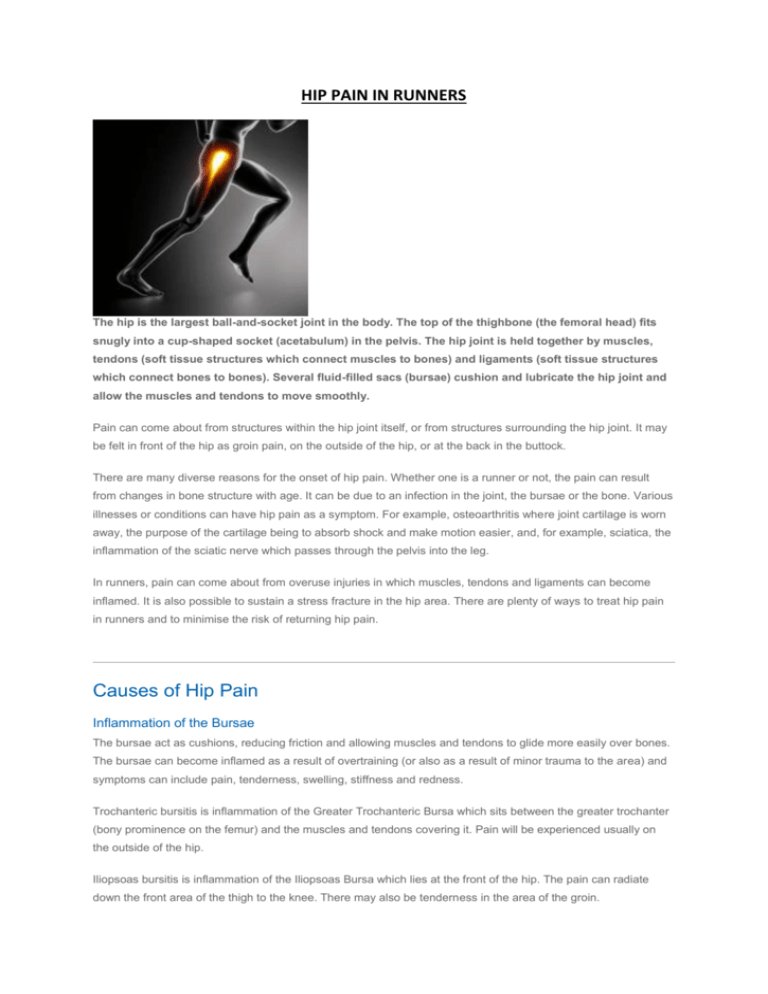
HIP PAIN IN RUNNERS The hip is the largest ball-and-socket joint in the body. The top of the thighbone (the femoral head) fits snugly into a cup-shaped socket (acetabulum) in the pelvis. The hip joint is held together by muscles, tendons (soft tissue structures which connect muscles to bones) and ligaments (soft tissue structures which connect bones to bones). Several fluid-filled sacs (bursae) cushion and lubricate the hip joint and allow the muscles and tendons to move smoothly. Pain can come about from structures within the hip joint itself, or from structures surrounding the hip joint. It may be felt in front of the hip as groin pain, on the outside of the hip, or at the back in the buttock. There are many diverse reasons for the onset of hip pain. Whether one is a runner or not, the pain can result from changes in bone structure with age. It can be due to an infection in the joint, the bursae or the bone. Various illnesses or conditions can have hip pain as a symptom. For example, osteoarthritis where joint cartilage is worn away, the purpose of the cartilage being to absorb shock and make motion easier, and, for example, sciatica, the inflammation of the sciatic nerve which passes through the pelvis into the leg. In runners, pain can come about from overuse injuries in which muscles, tendons and ligaments can become inflamed. It is also possible to sustain a stress fracture in the hip area. There are plenty of ways to treat hip pain in runners and to minimise the risk of returning hip pain. Causes of Hip Pain Inflammation of the Bursae The bursae act as cushions, reducing friction and allowing muscles and tendons to glide more easily over bones. The bursae can become inflamed as a result of overtraining (or also as a result of minor trauma to the area) and symptoms can include pain, tenderness, swelling, stiffness and redness. Trochanteric bursitis is inflammation of the Greater Trochanteric Bursa which sits between the greater trochanter (bony prominence on the femur) and the muscles and tendons covering it. Pain will be experienced usually on the outside of the hip. Iliopsoas bursitis is inflammation of the Iliopsoas Bursa which lies at the front of the hip. The pain can radiate down the front area of the thigh to the knee. There may also be tenderness in the area of the groin. Inflammation of the Iliotibial Band The iliotibial band is a tendon running from the hip, down the outside part of the thigh, to the knee. A tight band can cause hip pain or knee pain or both, and the band can also become inflamed. Stress Fracture A stress fracture can occur in the neck of the femur (femoral neck) as a result of overtraining, or as a result of incorrect training, using inappropriate footwear. A stress fracture is a break in the bone and it can be a partial break or complete break. It can be felt as groin pain when performing any weight-bearing activity. Treatment of Hip Pain Consult your doctor if you have concerns as to a correct diagnosis and how to proceed with your treatment, especially if the pain does not subside with rest and reduces the mobility of your hip or causes limping. There is a certain amount you can do to help yourself, but you may also wish to have physical therapy from a sports massage therapist, chiropractor, physiotherapist or other qualified practitioner. Treatment of Bursitis Rest – It is important to rest from running if running has brought the condition on. In the meantime, choose an alternative form of exercise which does not aggravate the problem. Ice – Use ice to reduce the inflammation and pain. Put ice on for 20 minutes out of every hour, 4 or more times in the first 1 to 2 days. Do not put the ice right on the skin. Heat – If the swelling is gone, heat can be used e.g. with a hot water bottle. Massage – Massage or rub your hip to relieve pain and help blood flow. Movement – Move the hip joint through its full range of motion each day to prevent stiffness. Anti-inflammatories – Use these if desired. Bursitis is likely to improve in a few days or weeks with rest and treatment. When you are ready to begin running again, start slowly and for short periods of time, or at a slower speed. Use ice afterwards. Treatment of Iliotibial Band Syndrome The treatments for bursitis can also be applied to ITBS. In addition, weak muscles should be strengthened and the outer hip muscles should be stretched. You may also wish to use a foam roller, for example the Grid, on the upper outer thigh, to make the IT band less tight. An inflamed IT band may take a few weeks to heal. Treatment of a Stress Fracture A stress fracture does not always show on an X-ray. An MRI scan (Magnetic Resonance Imaging) is the best study to assess whether a runner has sustained a stress fracture. Most stress fractures can be treated with rest from running, as the bone heals itself. Otherwise, if the fracture is more serious, further treatments are available. Prevention of Hip Pain Improve your flexibility by performing hip flexor stretches, hamstring stretches, pelvic tilts. Strengthen the muscles which are involved in the hip joint, through the use of specific exercises such as squats and lunges. Perform resistance exercises at least 2 days a week. Develop your core/torso muscles to improve stability and balance. Make sure you have a good diet with sufficient levels of vitamins and minerals. Maintain a good posture when sitting, standing and walking. This allows the hips to move and function normally, without undue strain. Develop and maintain a good running technique. Subtle changes to your running technique may make all the difference as to whether you experience hip pain or not. You could consider signing up for some Chi Running classes, given by a certified instructor. Be sure to wear the correct footwear for your gait. Buy your shoes from a trained running specialist, who will match the shoes to your foot strike If you wear cushioned shoes, keep a rough log of your mileage in each pair so that you do not continue to run when the shoes have lost their shock absorption. Resist overtraining. Try not to increase the intensity, duration or frequency of your training by more than 10% per week. The whole body, including the hips, needs time to adapt to the increased demands made of it. Summary If you start to experience any hip pain, look into it right away and see if you need to change anything in terms of your technique, footwear or overall strength and flexibility. Consult a running coach or a therapist for a professional opinion.



